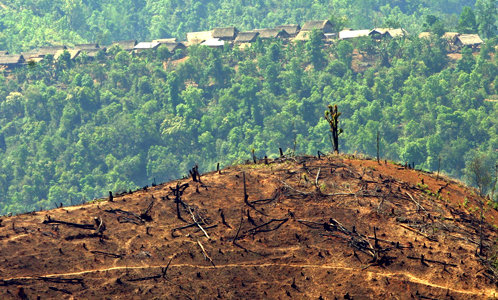Protecting Biodiversity and Preventing Pandemics
Protecting biodiversity will help prevent pandemics caused by diseases spread from animals to humans.
Protecting biodiversity will help prevent pandemics caused by diseases spread from animals to humans. This article was published in the November-December 2020 issue of NewsNotes.
As the world reels from the impacts of the coronavirus pandemic, scientists explain the connection between humanity’s impact on declining biodiversity and increasing frequency of “spillovers,” or human diseases which originate in animals. It is estimated that two-thirds of human diseases now originate in animals, facilitated by our practices of extensive clearing of wilderness areas and forests, catching wildlife, and selling meat in unsanitary places where it comes into contact with bats and wild birds.
Academic researchers, non-governmental organizations, and the United Nations are urging that biodiversity protection targets be implemented as one key method of preventing further outbreaks of pandemics similar to COVID-19. At the virtual UN Summit on Biodiversity held on September 30, UN Secretary General Antonio Guterres stated, “Humanity is waging war on nature and one consequence is the emergence of deadly diseases such as HIV/AIDS, Ebola and COVID-19. The degradation of nature is not purely an environmental issue. It spans economics, social justice and human rights, and can result in geopolitical tensions and conflicts.”
Speakers at the Summit explained that 13 million hectares of forest are lost every year, vertebrates have declined by 68 percent in the last fifty years, and in each year one million species of plant and animal life are at risk of extinction, caused by habitat loss, farming, poaching, pollution, invasive species, and climate change. Over the past few hundred years human population growth combined with increased, unsustainable production and consumption patterns have expanded demand for biological resources, which has in turn caused a dramatic loss of biological diversity.
The participants of the Summit concluded that if humanity continues down this path, food security, water supplies, and livelihoods will be threatened, as will our ability to fight diseases and handle extreme events.
The goal of protecting biodiversity is not new, but it is increasingly urgent. The UN Convention on Biological Diversity was adopted in 1992 and came into force in December 1993. It has been ratified by 196 countries, making it almost universal, with the notable exception of the United States. The Convention has three objectives: the conservation of biodiversity, sustainable use of its components, and equitable sharing of the benefits arising out of the utilization of genetic resources.
At the Convention on Biological Diversity Conference in Nagoya, Japan, in 2010, the Aichi Biodiversity Targets were adopted, containing five strategic goals and twenty ambitious targets. These targets were meant to guide action on biodiversity from 2011 to 2020, but at this year’s summit, Heads of State and Government Ministers expressed concern that none of the 2020 targets will be met.
The Convention uses the ecosystem approach, a strategy for the integrated management of land, water and living resources that promotes conservation and sustainability in an equitable way. The clearest example of biodiversity loss is the homogenization of agriculture: the Food and Agriculture Organization estimates that 75 percent of the genetic diversity in agricultural crops has been lost over the last century, while 75 percent of the world’s food is now generated from only twelve plants and five animal species. The erosion of agricultural biodiversity has made agricultural production vulnerable to pests, extreme climatic events, and market shocks.
In addition, the Global Assessment Report produced by the Intergovernmental Platform on Biodiversity and Ecosystem Services stated that 14 out of the 18 categories of “critical contributions” that nature provides to humanity have been greatly diminished since 1970, including the ability to regulate pollination, climate, and air quality. Furthermore, the Biodiversity Summit members concluded that our skewed relationship with nature is directly connected with the origin of COVID-19, part of the 60 percent of infectious diseases considered zoonotic, or originating in animal populations often under severe environmental pressure.
To confront this dire situation, several speakers at the Summit said that in addition to implementing Convention objectives and the Aichi targets there is a need to transform economic systems. “We need an economic system that prioritizes biodiversity as much as gross national product,” stated Munir Akram of Pakistan, the President of the Economic and Social Council. A shared responsibility for a “green reset” is needed, including provision of $300 to $400 billion annually to protect nature. Also, the real cost of nature’s services must be calculated when determining the total of a country’s annual production. “The time for polluting our way to wealth has passed,” said Inger Andersen, Director of the UN Environmental Programme.
The Convention is now aiming for the next Conference on Biological Diversity to take place in Kunming, China, in the spring of 2021, at which a new Global Biodiversity Framework will be finalized. Considering the dire problems facing our world, the bottom line is that a healthy natural world is our best anti-virus.

